As an Amazon Associate I earn from qualifying purchases.
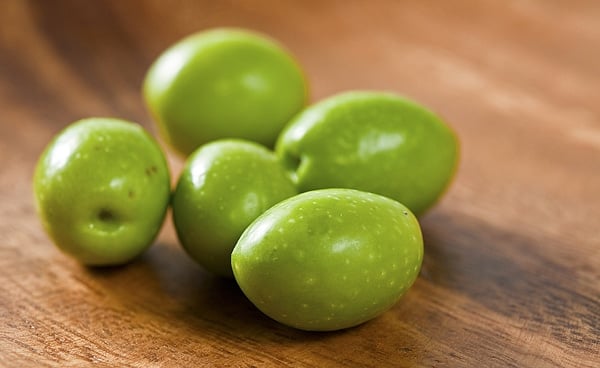
Lye. Isn’t that the stuff the Mafia uses to dissolve the bodies of those who’d made an unfortunate choice to use another waste disposal or vending machine company? Isn’t it drain cleaner, a deadly poison? So how on God’s Green Acre can lye be useful in the kitchen?
Relax. I am here to tell you that lye can be your friend, especially when it comes to curing green olives. A good lye cured olive, I have discovered, is uniquely smooth and luscious in a way that brine or water-cured olives can never be. Done right, they can be <gasp!> even better than a brine-cured olive or an oil-cured olive. Seriously.
Let me start by admitting that I was as terrified about using drain cleaner to cure olives as you are. Intellectually I knew it would work, and knew I’d eaten lye-cured olives before, as have most of us: They are those nasty black canned things also known as Lindsay olives. That knowledge, however, did not bolster my desire to do any lye curing anytime soon.
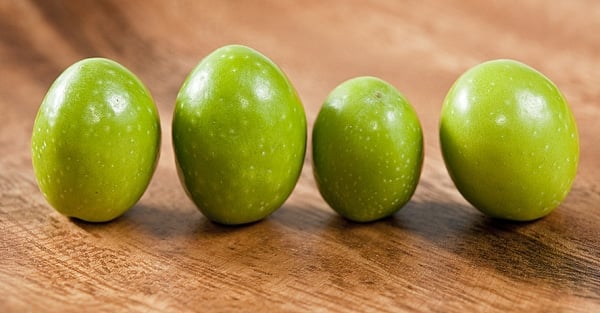
Then I did some research. I’d seen all sorts of references to how the lye cure — actually a cure in water that had percolated through wood ashes, which are a source of lye — being used “since Roman times.” Many hours of searching later, I found that the Roman agricultural writer Rutilius Taurus Aemilianus Palladius is the source of this, in his De Re Rustica, written in the 300s.
“Mix together a setier of passum, two handfuls of well-sifted cinders, a trickle of old wine and some cypress leaves. Pile all the olives in this mixture, saturate them with this paste in garnishing them with several layers, until you see it reach the edges of the containers.”
Passum is freshly extracted grape juice, so the lye in the ash-water interacting with this would make an interesting brew. There would be so much sugar going on in there that you could get both a lye cure and fermentation going at the same time. Freaky. Since then the Spanish have been masters of the lye cure. Most Spanish table olives are cured at least in part with lye, but their process is far different than that used in to make the hideous Lindsay olive. I am modifying a method I found in an agricultural book written in 1817.
Incidentally, other popular modern olives that use a lye cure include the French lucques, Italian cerignola and Spanish manzanilla.
First thing you need to know about curing olives with lye is that you must use fresh green olives. Not black ones, not half-ripe ones. The lye process softens the meat of the olive, so you want it as firm as possible. When you are picking your olives, watch out for olive fly. The larva of this nasty little bug burrows into an olive and eats it from within. Thankfully infested olives are easy to spot: They will ripen faster than healthy olives, and there is a tell-tale scar on the olive that looks like this:
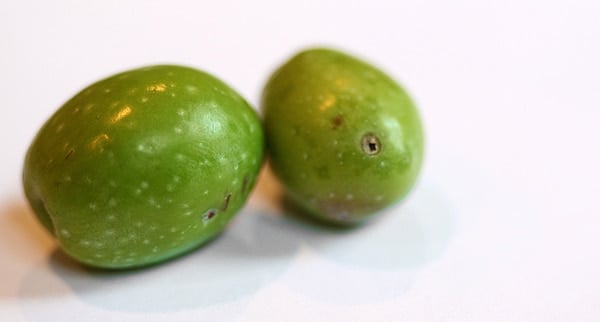
Toss that olive. While the worm is not poisonous, I prefer my olives sans extra protein, thank you.
What sort of lye do you use? The traditional brand to use is the classic Red Devil Lye, which is an old brand of drain cleaner. But all the science I’ve seen says anything that is 100 percent sodium hydroxide works, so scan your drain cleaner well to make sure it is nothing but lye — Drano used to be this way, but apparently has additives now. Don’t use it. Buy “food grade” lye if you want to, but after much research, I can find no hard evidence that there is any difference between so-called “food grade” lye and non-food grade lye. I’ve used both.
Isn’t lye a deadly poison? Sorta. Sodium hydroxide is one of the nastiest bases we know of; a base is the opposite of an acid. On the PH scale, distilled water is the median, at 7. Your stomach acid’s PH is about 1 1/2 — enough to burn a hole through a rug. Lye’s PH is 13.
Bottom line: Raw, pure lye will burn the hell out of you, but it is not a systemic poison. That means that even if you eat an olive that still has a lot of lye in it — as I did — all you will taste is a nasty soapy flavor. If you eat a bunch of them, the alkaline PH in the olives will counteract your stomach acid and it might give you indigestion. That’s all, and that’s a worst-case scenario. That said, you need to be careful at that one moment you are moving raw, pure lye from the container to the crock you are curing into.
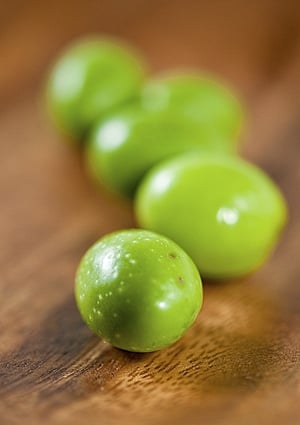
LYE CURING STEP BY STEP
Follow these instructions and you will be fine:
- Wear glasses if you have them. Wear long sleeves and pants and closed shoes. You will probably not get lye on you, but better to be safe.
- Pour 1 gallon of cold — not tepid, not hot, but cold — water into a stoneware crock, a glass container, a stainless steel pot, or a food-grade plastic pail. Under no circumstances should you use aluminum, which will react with the lye and make your olives poisonous.
- Using a measuring device that is not aluminum, add 3 tablespoons of lye to the water. Always add lye to water, not water to lye. A splash of unmixed lye can burn you. Stir well with a wooden spoon.
You’re done. You use cold water because the reaction between lye and water generates heat, and the hotter the lye-water solution, the softer the olives will become. Now that it is mixed, the lye solution can’t hurt you, so go ahead and add your olives.
Stir them in with that wooden spoon and put something over all the olives so they do not float. This is vital. Olives exposed to air while curing turn black. Don’t worry, they will absorb the water and sink in a few hours, but to start you need to submerge them.
Let this sit at room temperature for 12 hours. The alkaline solution will be seeping into the olives, breaking the bonds of the bitter oleuropein molecules, which then exit the olive and go into the water. After 12 hours, pour off the solution into the sink. It should be pretty dark in color.
Quickly resubmerge your olives in cold water. You want to minimize the exposure to air. You now have cured olives. I know, I know, a lot of recipes say to repeat the lye process another time — sometimes three more times — but that will destroy a lot of flavor; there are a ton of water-soluble flavor compounds in an olive that the lye solution washes away. Trust me. Your olives, unless they are gigantic, will not be overly bitter even after just a light, 12-hour lye soak.
Now you need to cleanse your olives. They will have a fair bit of lye solution in them now. Keep changing the water 2 to 4 times a day for 3 to 6 days, depending on the size of the olives. After 2 days, taste one: It should be a little soapy, but not too bitter. It’ll be bland, and a little soft. Once the water runs clear you should lose that soapy taste.
Time to brine. If you have large olives, make a brine of 3/4 cup salt to 1 gallon of water. And use good salt if you can. You will taste the difference. Kosher salt is OK, but ideally use a quality salt like Trapani, which is from Sicily. It’s not that expensive, but it is worlds better than regular salt.
Let the olives brine in this for 1 week. Keep them submerged, or you will get darkening. After a while they will sink. After 1 week, pour off the brine and make a new one, only this time, use 1 cup of salt per gallon.
Now you can play. The traditional Spanish cure would add some vinegar to the mix, as well as bay leaf and other spices. I’ve played with adding a touch of smoked salt, chiles, black pepper, coriander, mustard seed, garlic — think Mediterranean flavors.
But before you do this, taste your freshly brined olives. It will be a revelation. They will remain beautifully green, unlike brined olives. Salty, olive-y and very, very buttery. This is the Lay’s Potato Chips of olives. I dare you to eat just one.
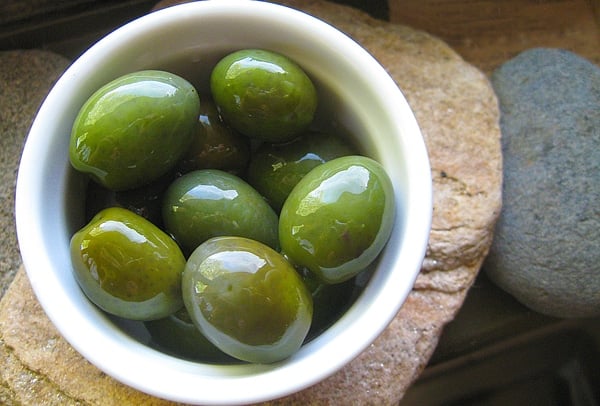
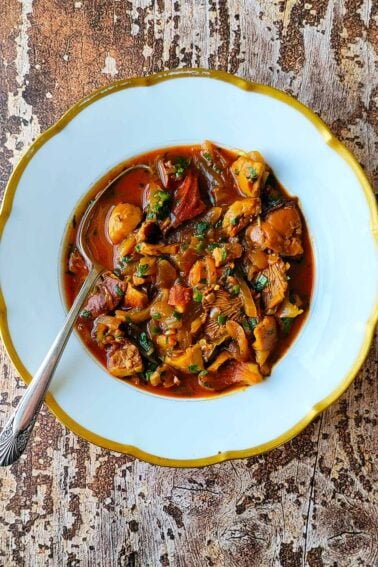
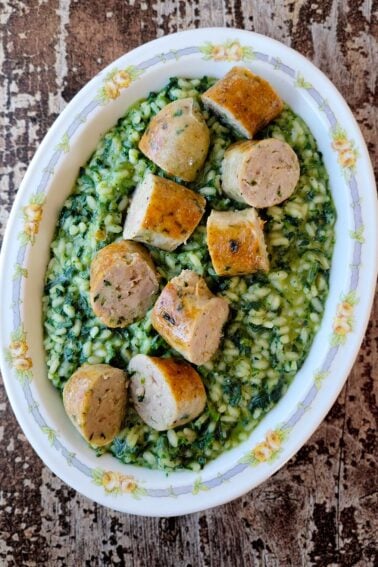
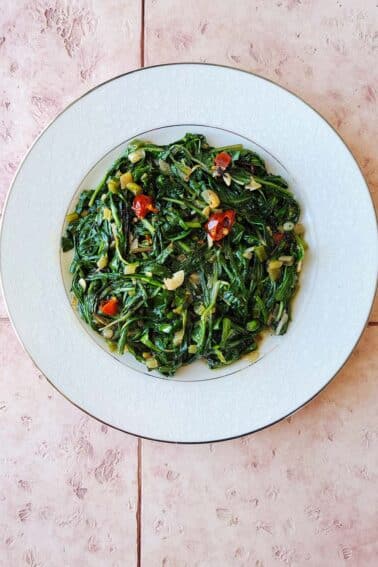
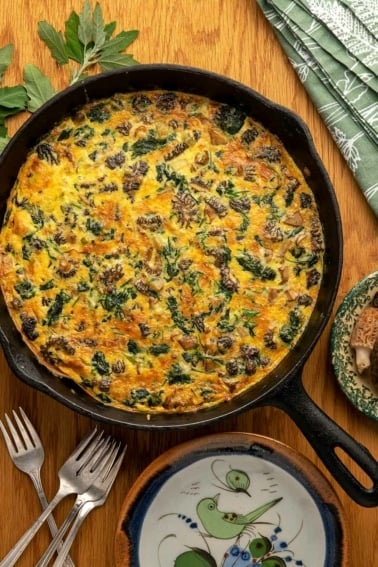
Hi Hank,
I just started the second and final brine and the olives turned out great! We planted a Manzanilla tree a couple of years ago and this is our first crop. They are on the small side, but my tree guy says they will be bigger next year after he prunes the tree in the fall.
I have done the before. Many years ago I worked in a power plant that had several old growth olive trees on the property. An old maintenance man showed me how to do it but his recipe was three baths of diminishing solution lye, followed by three baths of diminishing solution brine. I could not confirm that recipe anywhere on the web, so I went with yours, and it worked great. ALSO – the “olive flies” – we noticed infestation marks on some and I cut into the blemish and found little larva. I would not have known this if it weren’t for your website. We harvested 15 pounds, but tossed out 5 pounds that were infected. I’d like to know where these flies come from. There are no other olive trees in the neighborhood. And is there a safe insecticide?
We are now trying to figure out what seasoning to do. Thanks for your information. Can’t wait to do this again next year.
I suppose so, maybe next time I’ll leave the brightest magenta pinks out, it’s not a red wine kalamata color at all. Anyway, great site with great page about curing olives, thanks for the expert instructions. Need to find a local NYC market that sells raw olives at an affordable price.
Am not curing olives, have no source thst is reliably affordable, even so this is a longstanding family tradition to cure olives using wood ash. My question is when I buy Cerignola oliv3s and there are as many bright pinks as silky greens onthe barrel, thses olives ate not really market ready are they? Are bright pink Cerignola olives edible?
Agatha: If they are sold to you as ready-to-eat olives, I assume they are edible. And yes, I’ve seen pinkish olives in an olive mix before.
My olives went black because the lye leaked out are they still ok can I get them back to green.
Nuccia: Nope. They’re done for.
Hi Hank, thanks for your time and information on olives! After reading through this blog I just thought to add that measuring lye by weight rather than volume would be a way to get a more consistent result.
The U.C. Davis Ag Division recommends 2 oz. lye to 1 gallon water, which is what I use. For those on the metric side of things 1 Liter is roughly 1 quart (.95 qt) and 1 gallon is about 4 liters. And 2 oz. is roughly 56 grams and I haven’t had enough coffee to do the rest of the math, but there’s enough there to figure out proportions.
I make enough to cover the olives plus 2″ of additional lye mixture, using 5 gallon food grade buckets and use dinner plates (which fit nicely inside) to hold the olives under. 12 hours, then cut one to test for penetration. Larger olives usually go another 1/2 day, smaller olives a few hours less.
I also realize my follow up brine was too concentrated, causing the skins to wrinkle, so I’ll try the less briny solution you use and hopefully get a smoother skin.
thanks again!
I “found” a jar that I had brined last year, using rosemary, peppercorns, bay, chille pepper, and the left over skins from making lemoncello. They had been sitting under the counter for the last nine months. I had put them there as they were still quite bitter, and I didn’t know what to do with them.
Yum! Some were a little soft, but an extra half year in brine has made them perfect.
My olives are on the small side. What amounts should I mix for the brine process. Would it be less than what is posted of 3/4 cup salt to 1 gallon water and 1 cup salt to 1 gallon water.
Hank, this process worked perfectly for me! My favorite olives are the mild green variety, like Cerignola, that taste of olive and a bit of salt. The kind you pay $7 a pound for at the upscale grocery store;-) Followed your instructions pretty closely and was able to move about 3.75 pounds of green olives to the first salt brine step after four days; using 100% lye household ‘drain opener’ and my 2 gallon Igloo thermos. The texture is perfect and some day maybe I’ll know how long they last in the fridge (if I could stop eating them). My olives came from a San Joaquin Valley orchard via a farmer at the Inner Sunset Farmers’ Market. He’s bringing me 5 more pounds next week – now I’m hooked.
Hi, Hank. I’ve got several kilos of large Kalamatas to process so I’ll be trying the lye cure this year – the first batch is sitting in a lye bath tonight. Reading through the comments, it sounds like a 12 hour like soak might not be long enough for this larger variety of olive. Can I just let them soak longer in the same gallon of lye bath, or do I need to rinse the olives, then make up a fresh lye/cold water mixture? Thanks!
Hi hank!scored several gallons of nice green olives a few weeks ago, separated them by size, and have been lye curing them with your recipe for the last few days, but I’m stumped about a couple things. For one, many of my olives near the bottom of the jars I’m using have turned very soft and bright yellow after a few days soaking. I tossed them since they were so soft, is it because the lye at the bottom was too strong, and I didn’t stir them enough? Another jar seems to have the opposite oroblem, maybe the lye bath was too weak, and they are still very hard. If I salt brine these now, will the soft become super soft and the hard take a lot longer? Should I wait to add spices or vinegar if the hard ones haven’t soften up in a week or 2? Thanks!I’m a noob!
How much salt per gallon for the first brine?
Anthony: 1 cup of kosher salt, and I use Morton’s.
Hi. I tried this recipe but we must have messed up. Our olives are soft and squishy. We are trying it again. Is the second brining the time to put them in Jars? Do you do a cold pack? And is this when you add the flavoring? I must need more instruction.
I’ve been using your method for three years with fabulous results. Last year I canned 5 gallons of olives. They turn out great! This year my wife and I picked 15 gallons. Starting the lye process today. Thanks for the information!
Oh my goodness, Hank, I did it!! I just cured my first batch of green olives in lye and it was suuuuuper easy. Only took 2 1/2 days!!! I’d read and heard so many thing that made it seem much more complicated and a little scary but dude!! It was sooo not. Thanks for your site. Gave key information throughout that proved vital such as the superfluity of doing the lye process 2-3 times… NOT! I did it one time letting them soak in the solution for about 18 hours and that totally did the trick. AND I didn’t have to rinse as often either I think because I used a cooler instead of a bucket so I rinse/soaked them in about 3 times as much water. By the third rinse this morning they were buttery, gorgeous, and ready to pickle. Hallelujah! this is awesome!!!
Hello from Canada Hank!
I’m about to try this again this year (last year I had the same trouble as Marty above) . For the last brine (the flavoured one), would you be placing your olives into jars submerged in this brine for storage?
Please wish me luck! I so desperately want this to work this time!
Erin: Yep. The final brine has the flavors, and I usually keep it in a cool place for storage.
Hi, Hank: Trouble in River City! Lye soak went fine; darkness cleared in about four days. But brining hasn’t done so well. Salt solution and olives are turning very dark, with what appears to be bacterial growth on the brine surface. I used a Kosher salt which contains “yellow prussiate of soda.” Any ideas? Thanks!
Marty: Huh. Kosher salt is not supposed to be anything but sodium chloride. Mold on the surface isn’t a big deal though. Just skip that off.
Hi Hank: Any chance that you have cured using lye made from wood ash? I guess I’m just curious if there is any noticeable difference in flavor/texture or if NaOH is NaOH regardless of the source. It seems like a bit of a lengthy process to get to usable lye, but, hey, I’m the type of person that will have to give it a whirl at least once. And, I just realized that I have an endless supply of wood ash to boot! Any insight or am just going down the rabbit hole?
Brian: Sorry, never done it. If you figure it out, post it up here — I’d love to hear about it.
Just curious as to how long the olives will keep after they have been brined?
Brian: At least a year in the fridge.
Everything else I’ve read says to cut a slit in the olives. You don’t do this with lye curing? My box of olives just arrived and I don’t want to mess them up. If a slit is needed could you just pit them first?
Pam: Everyone else is wrong. This method works.
Hi, Hank: Thanks for the response on olive ripeness. Here in Las Vegas, I believe it’s time right now, as we have some pretty hot Summer wx. I have a batch rinsing as we write! Blessings to you and yours,.